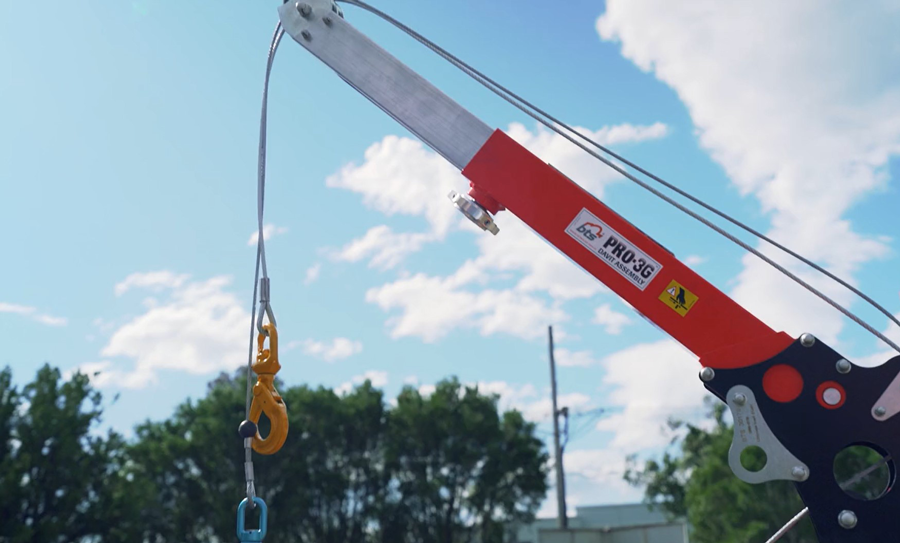How to use a davit arm and base system

How to use a davit arm and base system
As one of the leading suppliers of safety gear to the civil and infrastructure sectors, we often get asked about davit arm systems: specifically, how they work and how to stay safe when using them in confined spaces.
Here’s our run-down on what you need to know about davit arm and base systems, including how to properly set up and use a davit to access vertical confined spaces like manholes, trenches and sewers, and how to ensure you’re ready for a rescue operation should something goes wrong on site.
What is a davit system?
Davits are modular arm and base systems designed to provide a safe anchorage point for lowering a worker into a confined space, or for a rescue or retrieval situation. With the addition of a winch to the arm and base components, a worker can be lowered into a pit in a controlled manner and winched up easily as required.
On some models, the steel base of the davit is fixed in place whilst the arm can swivel 360 degrees. This means that a worker can easily clip into their harness on flat ground next to the entry point, then the arm can be rotated to lower them into the shaft or pit. It also means that davit bases can be installed next to multiple entry points in some cases. Other types of davits have a fixed arm and base, and others such as the model shown in this video are specifically designed to be clamped to shoring for trench access applications.
What kind of work is a davit system used for?
Davit systems are typically used to raise and lower workers who need to be winched into pits, manholes, tanks, trenches and vaults. This is usually part of routine work such as maintenance, testing, cleaning and monitoring of pumping stations, drainage systems, dams and underground tanks. They are also used for construction applications in the mining, infrastructure and utility industries.
However, davits also play a crucial role in rescue operations if things go awry on site. Having a permanent davit base installed next to a confined space entry point means that rescues can be performed quickly and safely.
Davit systems can also be used for more temporary applications by using freestanding bases that can be quickly set up as the need arises, and packed away after the job is done.
Whether your davit arm system needs to be configured for permanent or temporary access, they all provide a safe solution for entry into tight spaces and difficult to access areas.
How to set up a davit, step by step
- Install the barrel mount over an approved supporting structure (typically the shoring frame) and install the lower mast into the barrel mount
- Then, fit the upper mast into the lower mast and install the davit boom arm into the upper mast, ensuring all the components click together on both sides
- Install the winch into the bracket, ensuring the rescue handle is correctly located on the right-hand side when facing the trench
- Replace the locking pin in the rescue winch, and follow the instructions to correctly align the winch hook cable over the rollers, feeding it over the boom
- Now install the material winch on the special bracket outside of the davit. Make sure it engages properly and replace the locking pin.
- Release enough cable to feed it through the guides and rollers as shown in the video, and finally over the free rollers on the tip of the boom arm.
Your winch is now set up and ready for use.
Remember, the material winch is for material only, and the rescue winch is for rescue only.
Using a davit for access and fall protection when performing routine work
Jaybro’s range of davit arms and bases are designed to provide a supporting structure for personal fall arrest systems. When used with an appropriate safety harness, a davit system can be used to safely winch a worker into an opening so they can complete a task.
Additionally, with the use of a suitable winch, the davit arm can be used as a rescue device to assist with the rescue of a worker who has fallen and is being suspended by their harness.
Take a look at the video at the top of this article to see how the BTS Pro-3 Davit System can be set up specifically for working within a trench on a construction site.
Using a davit for rescue and retrieval
If you need to rescue a worker in a confined space, a davit arm, base and winch can be used as part of a system and process that meets the requirements of Australian Standard 1891 and 2865.
Always ask yourself ‘what if?’ and prepare for the worst-case scenario when working in a confined space situation. Being over-prepared is always better than being under prepared! And, remember the golden rule: never work alone. Having a spotter and multiple teammates on hand can be vital in an emergency situation.
It’s critical that workers are trained in performing rescue operations and practice drills should be performed at regular intervals to ensure all workers know what to do in an emergency. Safe Work guidelines and recommendations are different for different industries and throughout parts of Australia and New Zealand, so check with your local workplace safety authority and ask your WHS Representative for advice for your specific situation.
Keep reading: Jaybro Buyers Guide - Davits for Confined Space Access
Things to note
- With all confined space entry and rescue systems, a working load limit applies – make sure that you take note of the WLL of the equipment you are using, and that it is appropriate for the project. Some systems are made up of the davit arm, the base, the winch and the harness, and all may have different working load limits. Make sure you never exceed the working load limit of the lowest rated system component.
- When considering the weight of the worker or the material, note that the working load limit takes into account the worker, his or her clothing and equipment, and tools being carried, the harness they are wearing and anything they may pick up or retrieve from the pit.
- Also, winches are typically rated as ‘man’ or ‘material’ (or a combination of both) which determines how they should be used. This categorisation is there for your safety: make sure you’ve got the right equipment for the job.
- Where possible, don’t mix brands: all confined space entry systems are designed to work most effectively as a complete system, and therefore compatibility issues can arise when mixing components from different manufacturers. We recommend the BTS davit systems as well as our Jaybro davit arm and base kit. The BTS range includes a wide selection of fixed and portable bases and different types of davit arms that can be safely combined with other products within the matching Pro-1, Pro-2 or Pro-3 product lines.
- Take environmental factors and site characteristics into account and adapt your working processes and equipment selection to suit hazards that may arise on particular sites. This can include explosive atmospheres such as grain silos, poisonous gases, hot work, sharp edges, moving parts of proximity to machinery, and potential electrical hazards. If any of these safety hazards are present at your site, make sure they are taken into consideration when selecting equipment.
- Always read the manual for the equipment you’re using, ensure users are properly trained, and inspect the equipment before each use. Follow the manufacturer’s recommendations regarding maintenance of each component and if you’re not 100% sure of the product’s suitability for the task - don’t use it.
Get advice on how to choose a davit system for your project
Get in touch with Jaybro’s friendly safety team for advice and assistance in choosing an appropriate confined space entry system.
 Sign In
Sign In 

